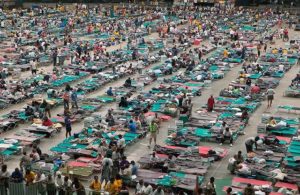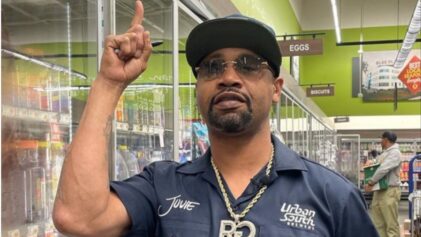
Thousands of hurricane Katrina survivors from New Orleans at a Red Cross shelter in the Houston Astrodome. FEMA photo/Andrea Booher Houston,TX.
As we mark the 10-year anniversary of Hurricane Katrina, many articles are analyzing what progress has been made in rebuilding New Orleans.
Hurricane Katrina resulted in $105 billion in damage, killed 2,000 people and disrupted the lives of many Black families. However, a recent tweet by the New York Times says New Orleans is a better place to eat after the storm.
According to figures from the New Orleans Urban League and the National Urban League, the Black community is worse off 10 years after Katrina.
NOLA.com reveals that, according to the Urban League report, the median income gap between Black and white households in New Orleans has widened by 18 percent from 2005 to 2013. The Urban League also stated that although 59 percent of the population was Black, only 48 percent of Black men were working. The study also found the number of Black children living in poverty had increased from 44 percent in 2005 to 50.5 percent in 2013.
National Urban League President Marc Morial suggested raising the minimum wage to help lift people out of poverty.
“I believe if people work, they ought to be able to afford the necessities of life,” he said. “When people earn more money, they will spend it in the economy. If Congress can’t [raise the minimum wage] and the state can’t do it, then the city should find a way do it.”
According to investigative reporter Greg Palast, Hurricane Katrina reshaped New Orleans’ demographics, as many Black service workers were evacuated only to see their positions filled by immigrant laborers who were willing to work for less. Palast has also investigated Katrina for Democracy Now! and explored the real causes behind the flood in the film, Big Easy to Big Empty.
“And so in terms of work, almost all—almost all the work of reconstruction was done by people who came in from El Salvador and from Latin America, cheap labor,” said Palast in an interview with Truthout. “And then the technical labor came from the north. So, basically it was also carpetbag labor, and local African Americans lost their jobs.”
He told the story of Stephen, a hotel worker who was evacuated and separated from his family during the flood. Stephen never returned.
“Stephen was put on a bus, separated from his family. He never saw his children and his wife for weeks,” Palast said. “He had no idea where they were shipped off to. And then he was dumped in Texas. He ended up taking a job in Texas, and his job at the Marriott Hotel in New Orleans was taken over by immigrant workers who would be willing to work nonunion and at half his pay. So you had—basically, the construction work was done almost entirely by immigrant workers, as opposed to the Black population which had lived there.”
Palast said many Black families lost their homes during the flood, and they were not allowed to reclaim their property. According to Palast, before Katrina, the Lower Ninth Ward had the highest concentration of Black homeownership in America.
“What happened was all these people were shipped out, put on buses, not even told where they were going, and sent to Texas, sent to Baltimore, sent all over, and sent to Florida, no way to return, no plan to return,” Palast said. “People weren’t allowed to return to their own homes, not even allowed to put trailers on their own property..”
Palast says post-Katrina New Orleans is a different city.
“So, basically, the Black population was cleansed out of the city and off the voter rolls, so that you actually—don’t forget, this is also another way to get rid of—to use a natural disaster as a cover to in effect cleanse the voter rolls as well,” Palast said. “The state went from a Democratic governor to Republican Bobby Jindal. Altogether, New Orleans went from a Black city to a white and Latin American city. It’s a very different city than it was.”


